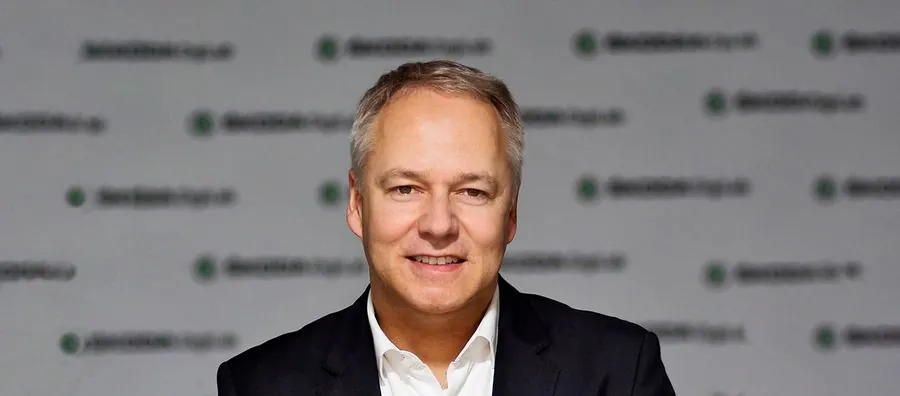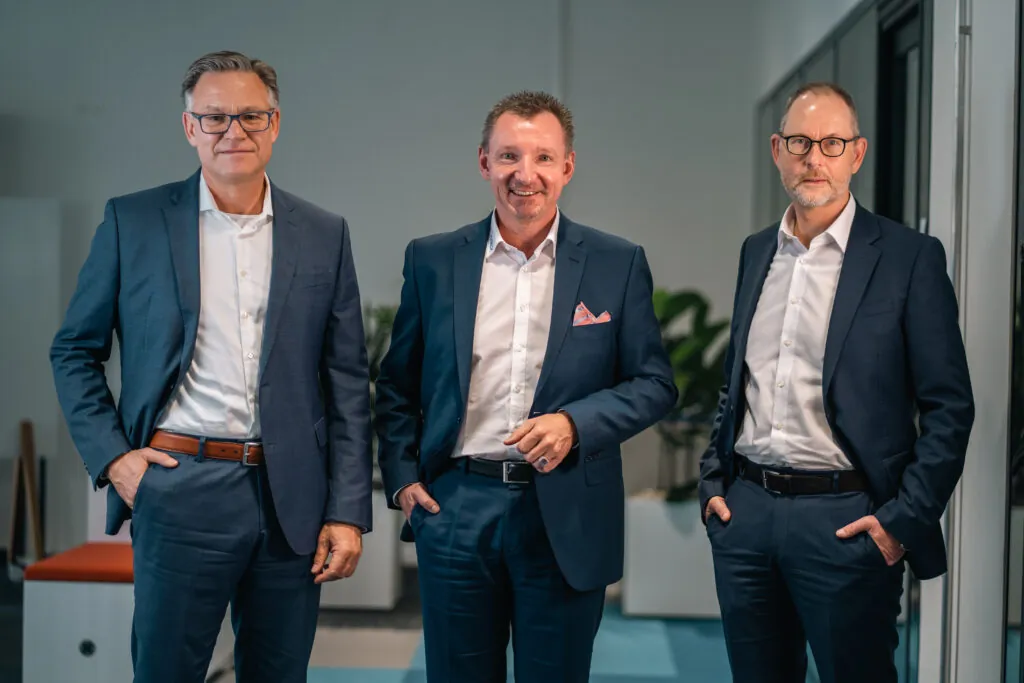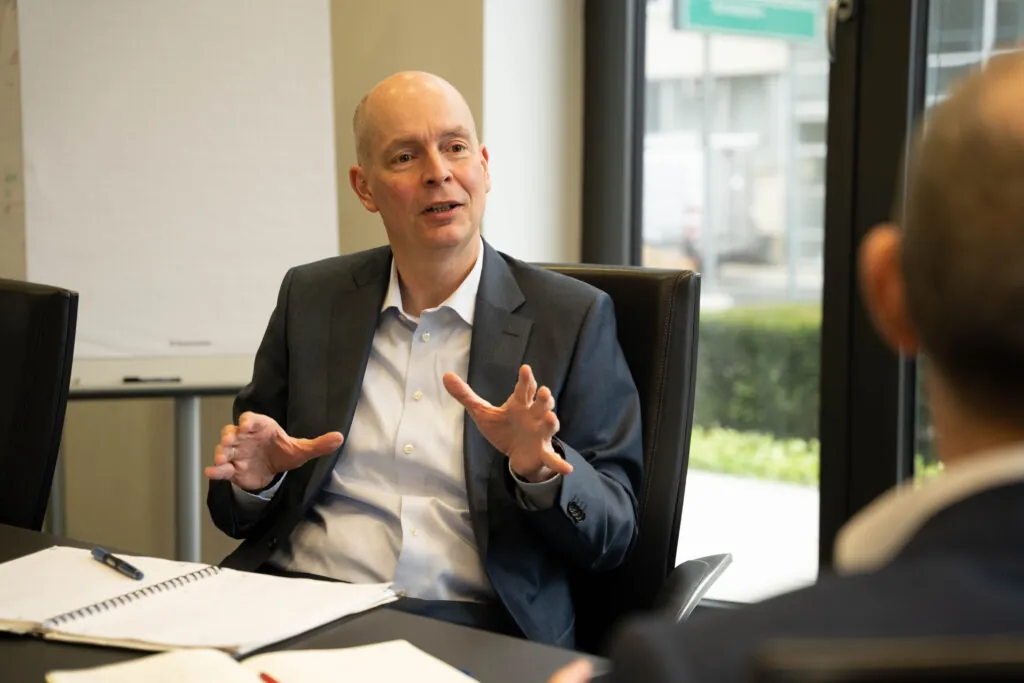
IT Organisation 2025

“If IT doesn’t pay close attention to the topic of data, it will have competition”
Thomas Heinevetter, Managing Director of the management consultancy kobaltblau, spoke to Andre Wehner, CIO at MAN Truck & Bus, about the collaboration between IT and business, product IT, handling data and the specific challenges of digital transformation at MAN Truck & Bus.
How will collaboration between the IT organization and the business change over the next five years?
Thomas Heinevetter: How will collaboration between the IT organization and the business change over the next five years? You can choose between four scenarios. 1. IT and business merge completely. Integrated teams work in a product-oriented way. 2. the IT breaks down into two parts. One part merges with the business, as in scenario 1, while the other part forms an IT platform. 3) IT partially merges with the business and is organized as product IT, in which business and IT work together in virtual teams. IT also remains the platform provider. 4 The fourth scenario is very similar to today’s IT organization. It is a hybrid model in which there are virtual teams from business and IT, but also classic plan-build-run elements. Which of the four do you think is the most likely?
Andre Wehner: That depends very much on the company in question. In the case of pure technology companies, I think a complete merger is very conceivable. I would formulate scenario 3 as the goal for our company. In future, business and IT will have to work much more closely together and learn a lot from each other. Virtual mixed teams seem to be ideal for this. I don’t believe in a complete merger for industrial companies because there is still too much silo thinking between the divisions and there is still no end-to-end view, no consistency and no focus on the end customer.
Heinevetter: Are there areas in which virtual product teams are more likely to get started than in others?
Wehner: We have started in the sales and marketing area. IT and business speak the same language and we were able to agree on a standardized IT platform very quickly. In my opinion, however, there is no generally applicable rule.
Heinevetter: Are there any areas that you think are more difficult?
Wehner: Mixed virtual teams should work in every area. Perhaps it is a little more complicated in production. But if both sides want it, it should work there too.
Heinevetter: Another aspect of cooperation between business and IT is the topic of citizen development. Do you see the use of low-code or no-code platforms by business users, the aforementioned citizen developers, as beneficial or negative? In the same way that shadow IT used to have negative connotations?
Wehner: Shadow IT as something negative stems from the IT mindset of the 1980s, when we were mainly on mainframes and IT was still a closed store. Today, IT that is not open to the needs and IT activities of the business side will fail. However, this does not mean that the specialist side can do whatever it wants. There are good reasons for the responsibilities of IT. Just think of higher-level governance and IT security.
Heinevetter: Nevertheless, it’s about finding the right balance. Do you believe that the democratization of IT and the establishment of citizen developers in the specialist area promotes the right kind of collaboration between IT and business?
Wehner: If citizen development is openly and transparently coordinated, then this is certainly beneficial. If the specialist department takes a submarine approach, then certainly not.
Heinevetter: Product orientation and product-oriented teams. Many companies are currently working on this. How do you see these issues and what do you think are the success factors for setting up product teams?
Wehner: The first question that needs to be answered is what product orientation is intended to achieve. When it comes to standardization in IT, for example, product orientation can work well. In the business sector, you have to take a very close look at what is really meant and intended. I notice that IT often still wants to be clearly assigned roles and responsibilities before it starts work. I think this approach is wrong. Success comes when business and IT clarify in advance what they want to achieve together and who takes on which role and responsibility.
Heinevetter: Many companies that are moving towards product orientation have set up a demand management system in recent years. How do you see this developing?
Wehner: The function is still needed, but at a more comprehensive level. Today, it’s about more than just discussing the implementation of a specific IT function with a department head. Particularly against the backdrop of digitalization and transformation, demand management must clearly understand the direction in which the company should develop, what priorities should be set and what it needs to do so.
Heinevetter: It sounds as if demand management is developing more in the direction of portfolio management and project portfolio management. How do you think the latter will work in the future?
Wehner: First, we need a clear medium and long-term plan. The company needs to know in which direction it wants to develop. Within this framework, an agile approach is very welcome. But without a frame there is no direction and without direction there is no structure.

Heinevetter: The topic of data is becoming increasingly critical to success. How much will the so-called data-driven organization change IT? Will there be a Chief Data Officer? Will a similar organization develop around the topic of data as was the case with IT?
Wehner: If IT does not pay close attention to the issue of data, it will face competition. This means that if IT doesn’t pick up on this, other areas in the company will take care of it. I myself am often surprised at how little data is used overall. This is not true for structured data, but we work far too little with unstructured data. We often do not make our decisions based on data, but rather to the best of our knowledge and belief. Data and technologies are available to make data-based decisions.
Heinevetter: What level of maturity would you give your company in terms of data governance, data management, data analytics/data science and data infrastructure? And which fields of action in the area of data do you consider to be the most important?
Wehner: Like many other industrial companies, we are at the beginning when it comes to data – in terms of what can be achieved with data usage today. Today, we have neither progressive data management nor advanced analysis, except for core processes and structured data. We are still struggling with new topics and unstructured data. But we definitely need to improve in this area, because these fields are also interesting for our customers. If we want to move further in the direction of digital business areas, we definitely need to massively expand our data skills.
Heinevetter: What role does IT play at MAN when it comes to data?
Wehner: We do not yet have an overarching data strategy. We are only just developing this, and this also applies to responsibilities.
Heinevetter: What is MAN’s approach to transformation? Do you prefer the iterative approach in IT or in business or are you pursuing the big bang approach and synchronizing both in one big step?
Wehner: In my first six months as CIO, I have created transparency as to where we stand together on the IT and business side. My focus is now on how we will continue to develop the company in terms of transformation. This is also reflected in the IT strategy that we are currently developing. In it, we define the requirements of IT and the specialist departments so that we know where and at what speed we can drive the topics forward.
Heinevetter: Speaking of themes. What are your three top treatment areas?
Wehner: The focus is on the IT strategy and its alignment with the overarching new MAN strategy. At MAN Truck & Bus, we have a huge transformation to master. In my opinion, this is much greater than in the passenger car sector. In addition to electromobility, we also need to focus intensively on autonomous driving and digital business models. For IT, it depends on how we can best support this transformation. Once this has been clarified, it is also about the model of cooperation between IT and business, who takes on which roles and responsibilities.

Andre Wehner
Andre Wehner, 51 years old, began his professional career at ALCATEL in 1993. After around 10 years, he moved to Kabel Deutschland as CIO. His other professional positions include E-Plus, AUDI and the VW Group, where he was COO and CIO. At SKODA, he was responsible for corporate development and digitalization. Andre Wehner has been Chief Information Officer at MAN Truck & Bus SE since June 1, 2021.




